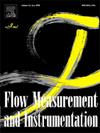Research on hydraulic characteristics and discharge calculation methods for top-hinge trapezoidal gates
IF 2.7
3区 工程技术
Q2 ENGINEERING, MECHANICAL
引用次数: 0
Abstract
This study proposes a novel type of flat sluice gate – top-hinge trapezoidal gate, which is suitable for integrated flow measurement and control in canal systems at various levels in irrigation districts or for medium and small-scale water diversion canals. This paper investigates the hydraulic characteristics of the top-hinge trapezoidal gate under free-flow and submerged-flow through both theoretical and experimental methods. A total of 192 groups of free-flow tests and 384 groups of submerged-flow tests were conducted. Based on the experimental data and theoretical analysis, threshold condition formulas were proposed, achieving accuracy rates of 100 % for free flow and 98 % for submerged flow. Discharge equations for the top-hinge trapezoidal gate were established and evaluated. The average relative errors were 2.05 % for free-flow and 2.21 % for submerged-flow when derived from dimensional analysis, and 3.04 % and 3.39 %, respectively, when using the equations derived from the energy conservation method. The dimensional analysis method yielded slightly higher accuracy than the energy conservation method. The research findings provide important theoretical and practical guidance for the application of top-hinge trapezoidal gates.
上铰梯形闸门水力特性及流量计算方法研究
本文提出了一种适用于灌区各级渠系或中小型引水渠综合流量测控的新型平面水闸——顶铰梯形水闸。本文采用理论和实验两种方法研究了上铰梯形闸门在自由流动和淹没流动条件下的水力特性。共进行了192组自由流试验和384组沉流试验。在实验数据和理论分析的基础上,提出了阈值条件公式,自由流和淹没流的阈值条件准确率分别达到100%和98%。建立了顶铰梯形闸门的流量方程,并对其进行了计算。采用量纲分析得到的自由流动方程的平均相对误差为2.05%,水下流动方程的平均相对误差为2.21%,采用能量守恒法得到的方程的平均相对误差分别为3.04%和3.39%。量纲分析法的精度略高于能量守恒法。研究结果为上铰梯形闸门的应用提供了重要的理论和实践指导。
本文章由计算机程序翻译,如有差异,请以英文原文为准。
求助全文
约1分钟内获得全文
求助全文
来源期刊

Flow Measurement and Instrumentation
工程技术-工程:机械
CiteScore
4.30
自引率
13.60%
发文量
123
审稿时长
6 months
期刊介绍:
Flow Measurement and Instrumentation is dedicated to disseminating the latest research results on all aspects of flow measurement, in both closed conduits and open channels. The design of flow measurement systems involves a wide variety of multidisciplinary activities including modelling the flow sensor, the fluid flow and the sensor/fluid interactions through the use of computation techniques; the development of advanced transducer systems and their associated signal processing and the laboratory and field assessment of the overall system under ideal and disturbed conditions.
FMI is the essential forum for critical information exchange, and contributions are particularly encouraged in the following areas of interest:
Modelling: the application of mathematical and computational modelling to the interaction of fluid dynamics with flowmeters, including flowmeter behaviour, improved flowmeter design and installation problems. Application of CAD/CAE techniques to flowmeter modelling are eligible.
Design and development: the detailed design of the flowmeter head and/or signal processing aspects of novel flowmeters. Emphasis is given to papers identifying new sensor configurations, multisensor flow measurement systems, non-intrusive flow metering techniques and the application of microelectronic techniques in smart or intelligent systems.
Calibration techniques: including descriptions of new or existing calibration facilities and techniques, calibration data from different flowmeter types, and calibration intercomparison data from different laboratories.
Installation effect data: dealing with the effects of non-ideal flow conditions on flowmeters. Papers combining a theoretical understanding of flowmeter behaviour with experimental work are particularly welcome.
 求助内容:
求助内容: 应助结果提醒方式:
应助结果提醒方式:


